From Local Structure to Overall Performance: An Overview on the Design of an Acoustic Coating
Abstract
:1. Introduction
2. Conventional Design Process for Acoustic Coatings
3. Local Design of Acoustic Coatings
3.1. Acoustic Cavity Design and Optimization on Passive Acoustic Coatings
3.2. Acoustic Properties of Passive Acoustic Coatings with Rigid Inclusions or Scatterers
3.3. Passive Acoustic Coatings with Hybrid Structure
3.4. Design on Semi-Active/Active Acoustic Coatings
4. Overall Design on Acoustic Coatings
5. Summary and Outlook
5.1. Summary
- (1)
- Although the local-structure design based on traditional acoustic theory is clear, its preparation is difficult, or the parameters of the prepared materials are contradictory to the setting parameters, which make it hard to achieve the expected performance [10].
- (2)
- Some theoretical studies are limited in terms of preparation techniques, and they lack experimental verification. Examples are specified in Table A1 of Appendix A. Owing to its complicated structure, preparation of acoustic coating is difficult, which cannot be verified by experiments, thus making it more difficult for practical applications.
- (3)
- Few researches focus on other performance requirements for acoustic coatings during design, such as temperature performance [52], inspection [53]. In different seas, depths, and seasons, seawater temperature changes significantly [1]. For more realistic underwater conditions, it is suggested to investigate mechanical and acoustic performances (such as complex elastic modulus) of elastomers in different temperatures and pressures [52].
- (4)
- Researches on low-frequency sound absorption of acoustic coatings are few, especially the study of underwater acoustic materials below 1000 Hz.
5.2. Outlook
- (1)
- Compared to passive control, the active control of sound waves is more adaptable and has broad application prospects. Accordingly, the design of active acoustic coatings will be a major direction for future development.
- (2)
- Overall modeling and prediction of acoustic coatings under the coupling state of the shell structure require further study. When acoustic coatings are fabricated on the shell, acoustic characteristics in the coupling state of the structure and fluid are different from that in the natural state [54].
- (3)
- Applications of other acoustic metamaterials in underwater environments are also worthy of further research, such as thin-film acoustic metamaterials [55,56], Helmholtz resonator type acoustic metamaterials [57], double-negative (negative effective density and negative bulk modulus) acoustic metamaterials [58], acoustic cloak [59], and so on.
- (4)
- Theoretical breakthroughs have been brought by the electricity–mechanics–acoustics analogy [60] and mutual learning between acoustic methods and optical methods; structural design breakthrough brought by bionics [61]. Modern acoustics has a strong crossover and extensibility. This is especially true on the design of acoustic coatings. It involves various fields, such as mechanical engineering, material, chemical industry, etc., which requires communication and cooperation between scholars in different fields, and the strengthening of our own study in these fields.
- (1)
- The realization of low-frequency sound absorption performance of acoustic coatings without increasing thickness and weight of materials.
- (2)
- The guarantee of strong sound absorption effect of acoustic coatings in low frequency and broadband range.
- (3)
- The maintenance of sound absorption performance of acoustic coatings under deep-sea hydrostatic pressure.
Author Contributions
Funding
Conflicts of Interest
Appendix A
| References | Theoretical/ Numerical Work | Experimental Work | Year of Publication | References | Theoretical/ Numerical Work | Experimental Work | Year of Publication |
|---|---|---|---|---|---|---|---|
| 15 | √ | 2018 | 34 | √ | 2019 | ||
| 16 | √ | 2018 | 35 | √ | 2015 | ||
| 17 | √ | √ | 2010 | 36 | √ | 2019 | |
| 18 | √ | 2017 | 37 | √ | 2019 | ||
| 19 | √ | 2019 | 38 | √ | 2017 | ||
| 20 | √ | 2018 | 39 | √ | 2019 | ||
| 21 | √ | 2016 | 40 | √ | 2017 | ||
| 22 | √ | 2018 | 41 | √ | √ | 2015 | |
| 23 | √ | 2018 | 42 | √ | √ | 2019 | |
| 24 | √ | 2019 | 43 | √ | √ | 2014 | |
| 25 | √ | 2017 | 44 | √ | √ | 2017 | |
| 26 | √ | √ | 2016 | 45 | √ | 2013 | |
| 27 | √ | √ | 2012 | 46 | √ | 2014 | |
| 30 | √ | 2012 | 47 | √ | 2016 | ||
| 31 | √ | √ | 2009 | 48 | √ | √ | 2017 |
| 32 | √ | √ | 2012 | 49 | √ | √ | 2018 |
| 33 | √ | 2017 | 50 | √ | 2018 |
References
- Zhu, B.L.; Huang, X.C. Key Technologies for Submarine Stealth Design of Acoustic Coating; Shanghai Jiao Tong University Press: Shanghai, China, 2012. (In Chinese) [Google Scholar]
- Sun, W.H.; Gao, K.J.; Liu, B. Research of underwater vehicles acoustic stealthy materials. J. Qingdao Univ. Sci. Technol. Nat. Sci. Ed. 2017, 38, 67–74. (In Chinese) [Google Scholar]
- Yoo, C.M.; Joo, J.; Lee, S.H.; Ko, Y.; Chi, S.B.; Kim, H.J.; Seo, I.; Hyeong, K. Resource assessment of polymetallic nodules using acoustic backscatter intensity data from the Korean exploration area, northeastern equatorial pacific. Ocean Sci. J. 2018, 53, 381–394. [Google Scholar] [CrossRef]
- Boswarva, K.; Butters, A.; Fox, C.J.; Howe, J.A.; Narayanaswamy, B. Improving marine habitat mapping using high-resolution acoustic data; a predictive habitat map for the Firth of Lorn, Scotland. Cont. Shelf Res. 2018, 168, 39–47. [Google Scholar] [CrossRef]
- Bacheler, N.M.; Shertzer, K.W.; Buckel, J.A.; Rudershausen, P.J.; Runde, B.J. Behavior of gray triggerfish Balistes capriscus around baited fish traps determined from fine-scale acoustic tracking. Mar. Ecol. Prog. Ser. 2018, 606, 133–150. [Google Scholar] [CrossRef]
- Brown, M.G.; Godin, O.A.; Zang, X.; Ball, J.S.; Zabotin, N.A.; Zabotina, L.Y.; Williams, N.J. Ocean acoustic remote sensing using ambient noise: Results from the Florida Straits. Geophys. J. Int. 2016, 206, 574–589. [Google Scholar] [CrossRef]
- Simmonds, M.P.; Dolman, S.J.; Jasny, M.; Parsons, E.C.M.; Weilgart, L.; Wright, A.J.; Leaper, R. Marine noise pollution--increasing recognition but need for more practical action. J. Mar. Technol. Soc. 2014, 9, 71–90. [Google Scholar]
- Chen, M. Investigation of Broadband Absorption Mechanisms of Underwater Sound-Absrobing Materials Based on Coupled Resonators. Ph.D. Thesis, University of Chinese Academy of Sciences, Beijing, China, 2015. (In Chinese). [Google Scholar]
- Méresse, P.; Audoly, C.; Croënne, C.; Hladky-Hennion, A.C. Acoustic coatings for maritime systems applications using resonant phenomena. C. R. Mec. 2015, 343, 645–655. [Google Scholar] [CrossRef]
- Qian, C.; Li, Y. Review on Multi-scale Structural Design of Submarine Stealth Composite. In Proceedings of the 2017 2nd International Conference on Architectural Engineering and New Materials, Guangzhou, China, 25–26 February 2017; DEStech Publications: Lancaster, PA, USA, 2017. [Google Scholar] [Green Version]
- Zhou, Q. Research on Active Control of Acoustic Wave Based on Metamaterial. Master’s Thesis, Harbin Institute of Technology, Harbin, China, 2016. (In Chinese). [Google Scholar]
- Audoly, C. Perspectives of Metamaterials for Acoustic Performances of Submerged Platforms and Systems. In Proceedings of the Undersea Defence Technology Conference 2016, Oslo, Norway, 1–3 June 2016. [Google Scholar]
- Hladky-Hennion, A.C.; Decarpigny, J.N. Analysis of the scattering of a plane acoustic wave by a doubly periodic structure using the finite element method: Application to Alberich anechoic coatings. J. Acoust. Soc. Am. 1991, 90, 3356–3367. [Google Scholar] [CrossRef]
- Easwaran, V.; Munjal, M.L. Analysis of reflection characteristics of a normal incidence plane wave on resonant sound absorbers: A finite element approach. J. Acoust. Soc. Am. 1993, 93, 1308–1318. [Google Scholar] [CrossRef]
- Zhou, F.; Fan, J.; Wang, B.; Peng, Z. Absorption Performance of an Anechoic Layer with a Steel Plate Backing at Oblique Incidence. Acoust. Aust. 2018, 46, 317–327. [Google Scholar] [CrossRef]
- Zhao, D.; Zhao, H.; Yang, H.; Wen, J. Optimization and mechanism of acoustic absorption of Alberich coatings on a steel plate in water. Appl. Acoust. 2018, 140, 183–187. [Google Scholar] [CrossRef]
- Zeqiri, B.; Gélat, P.; Norris, M.; Robinson, S.; Beamiss, G.; Hayman, G. Design and Testing of a Novel Alberich Anechoic Acoustic Tile. In Proceedings of the 39th International Congress on Noise Control Engineering 2010, Lisbon, Portugal, 13–15 June 2010. [Google Scholar]
- Sharma, G.S.; Skvortsov, A.; MacGillivray, I.; Kessissoglou, N. Sound transmission through a periodically voided soft elastic medium submerged in water. Wave Motion 2017, 70, 101–112. [Google Scholar] [CrossRef]
- Tao, M.; Ye, H.; Zhao, X. Acoustic performance prediction of anechoic layer using identified viscoelastic parameters. J. Vib. Control 2019, 25, 1164–1178. [Google Scholar] [CrossRef]
- Sohrabi, S.H.; Ketabdari, M.J. Numerical simulation of a viscoelastic sound absorbent coating with a doubly periodic array of cavities. Cogent Eng. 2018, 5, 1529721. [Google Scholar] [CrossRef]
- Liu, G.Q.; Lou, J.J.; Li, H.T. Absorption Characteristics of Multi-layered Material Anechoic Coating on Frustum-of-a-cone Cavities. In MATEC Web of Conferences; EDP Sciences: Les Ulis, France, 2016. [Google Scholar]
- Huang, L.; Xiao, Y.; Wen, J.; Zhang, H.; Wen, X. Optimization of decoupling performance of underwater acoustic coating with cavities via equivalent fluid model. J. Sound Vib. 2018, 426, 244–257. [Google Scholar] [CrossRef]
- Ye, H.F.; Tao, M.; Zhang, W.Z. Modeling and Sound Insulation Performance Analysis of Two Honeycomb-hole Coatings. In Journal of Physics: Conference Series; IOP Publishing: Bristol, UK, 2018. [Google Scholar]
- Park, S.J.; Kim, J. Simulation of underwater echo reduction using miniaturized Helmholtz resonators. J. Acoust. Soc. Korea 2019, 38, 67–72. (In Korean) [Google Scholar]
- Zhang, C.; He, S.P.; Yi, S.Q. Model and absorption performance of anechoic coating embedding sphere cavities. J. Ship Mech. 2017, 21, 99–106. (In Chinese) [Google Scholar]
- Zhou, J.L.; Yin, J.F.; Wen, J.H.; Yu, D.L. Underwater Insulation Properties and Mechanisms of Alberich Anechoic Coating. In Proceedings of the 2016 national conference on acoustics, Hubei, China, 11–13 February 2016. (In Chinese). [Google Scholar]
- Sun, Y.F.; Zhang, Y.B.; Wang, X.W.; Wang, B. Research on the Influence of Restraint Structure on Acoustic Performance of Sound Insulation and Decoupling Materials. In Proceedings of the 2012 academic conference on ship materials and engineering applications, Gansu, China, 16–17 December 2012. (In Chinese). [Google Scholar]
- Spero, A.C.; Godoy, C.M.; Harari, A.; Teague, J.M. Pressure Resistant Anechoic Coating for Undersea Platforms. U.S. Patent 7,205,043, 2007. [Google Scholar]
- Liu, Z.; Zhang, X.; Mao, Y.; Zhu, Y.Y.; Yang, Z.; Chan, C.T.; Sheng, P. Locally resonant sonic materials. Science 2000, 289, 1734–1736. [Google Scholar] [CrossRef] [PubMed]
- Ivansson, S.M. Anechoic coatings obtained from two-and three-dimensional monopole resonance diffraction gratings. J. Acoust. Soc. Am. 2012, 131, 2622–2637. [Google Scholar] [CrossRef] [PubMed]
- Jiang, H.; Wang, Y.; Zhang, M.; Hu, Y.; Lan, D.; Zhang, Y.; Wei, B. Locally resonant phononic woodpile: A wide band anomalous underwater acoustic absorbing material. Appl. Phys. Lett. 2009, 95, 104101. [Google Scholar] [CrossRef] [Green Version]
- Jiang, H.; Wang, Y. Phononic glass: A robust acoustic-absorption material. J. Acoust. Soc. Am. 2012, 132, 694–699. [Google Scholar] [CrossRef] [Green Version]
- Lewińska, M.A.; Kouznetsova, V.G.; Van Dommelen, J.A.W.; Krushynska, A.O.; Geers, M.G.D. The attenuation performance of locally resonant acoustic metamaterials based on generalised viscoelastic modelling. Int. J. Solids Struct. 2017, 126, 163–174. [Google Scholar] [CrossRef]
- Sharma, G.S.; Skvortsov, A.; MacGillivray, I.; Kessissoglou, N. Acoustic performance of periodic steel cylinders embedded in a viscoelastic medium. J. Sound Vibr. 2019, 443, 652–665. [Google Scholar] [CrossRef]
- Zhong, J.; Wen, J.H.; Zhao, H.G.; Yin, J.F.; Yang, H.B. Effects of core position of locally resonant scatterers on low-frequency acoustic absorption in viscoelastic panel. Chin. Phys. B 2015, 24, 084301. [Google Scholar] [CrossRef]
- Shi, K.; Jin, G.; Liu, R.; Ye, T.; Xue, Y. Underwater sound absorption performance of acoustic metamaterials with multilayered locally resonant scatterers. Results Phys. 2019, 12, 132–142. [Google Scholar] [CrossRef]
- Gao, N.; Zhang, Y. A low frequency underwater metastructure composed by helix metal and viscoelastic damping rubber. J. Vib. Control 2019, 25, 538–548. [Google Scholar] [CrossRef]
- Yu, Y.L. Optimization of Sound Absorption Performance of Underwater Composite Structure. Master’s Thesis, Huazhong University of Science Technology, Wuhan, China, 2017. [Google Scholar]
- Sharma, G.S.; Skvortsov, A.; MacGillivray, I.; Kessissoglou, N. Sound absorption by rubber coatings with periodic voids and hard inclusions. Appl. Acoust. 2019, 143, 200–210. [Google Scholar] [CrossRef]
- Feng, L.; Li, S.P.; Hu, Q. The Research of Damped Absorbing Layer Based on Piezoelectric Shunt. In Proceedings of the 2017 Symposium on Piezoelectricity, Acoustic Waves, and Device Applications (SPAWDA), Chengdu, China, 27–30 October 2017. [Google Scholar]
- Sun, Y.; Li, Z.; Huang, A.; Li, Q. Semi-active control of piezoelectric coating’s underwater sound absorption by combining design of the shunt impedances. J. Sound Vib. 2015, 355, 19–38. [Google Scholar] [CrossRef]
- Zhang, Z.; Huang, Y.; Huang, Q. Low-frequency broadband absorption of underwater composite anechoic coating with periodic subwavelength arrays of shunted piezoelectric patches. Compos. Struct. 2019, 216, 449–463. [Google Scholar] [CrossRef]
- Lee, J.W.; Woo, S.; Jang, H.; Lee, K.; Kim, W.G.; Kang, H.S.; Ohm, W.S.; Park, Y.; Yoon, S.W.; Seo, Y. Low-frequency active echo reduction using a tile projector. J. Acoust. Soc. Korea 2014, 33, 366–374. (In Korean) [Google Scholar] [CrossRef]
- Wang, W.; Thomas, P.J. Low-frequency active noise control of an underwater large-scale structure with distributed giant magnetostrictive actuators. Sens. Actuator A Phys. 2017, 263, 113–121. [Google Scholar] [CrossRef] [Green Version]
- Zhang, Y.B.; Ren, C.Y.; Zhu, X. Research on Vibration and Sound Radiation from Submarine Functionally Graded Material Nonpressure Cylindrical Shell; Advanced Materials Research; Trans Tech Publications: Stafa-Zurich, Switzerland, 2013. [Google Scholar]
- Zhang, C.; Shang, D.; Xiao, Y. Prediction of Anechoic Coating’s Equivalent Material Parameters by Matched-velocity. In Proceedings of the 21st International Congress on Sound and Vibration 2014, Beijing, China, 13–17 July 2014. [Google Scholar]
- Jin, Z.; Yin, Y.; Liu, B. Equivalent modulus method for finite element simulation of the sound absorption of anechoic coating backed with orthogonally rib-stiffened plate. J. Sound Vibr. 2016, 366, 357–371. [Google Scholar] [CrossRef] [Green Version]
- Kwon, H.W.; Hong, S.Y.; Song, J.H. A study for acoustic target strength characteristics of submarines using kirchhoff approximation. Mar. Technol. Soc. J. 2017, 51, 52–58. [Google Scholar] [CrossRef]
- Kim, J.Y.; Hong, S.Y.; Cho, B.G.; Song, J.H.; Kwon, H.W. Development of Acoustic Target Strength Near-Field Equation for Underwater Vehicles. Available online: https://journals.sagepub.com/doi/abs/10.1177/1475090218779292. (accessed on 11 March 2019).
- Bo, H. Research of Statistical Characteristics of Target Strength of a Single-layer Cylindrical Shell with Random Coating. In IOP Conference Series: Earth and Environmental Science; IOP Publishing: Bristol, UK, 2018. [Google Scholar]
- Wang, Y.R.; Miao, X.H.; Jiang, H.; Chen, M.; Liu, Y.; Xu, W.S.; Meng, D. Review on underwater sound absorption materials and mechanisms. Adv. Mech. 2017, 47, 92–121. (In Chinese) [Google Scholar]
- Huang, Y.; Hou, H.; Oterkus, S.; Wei, Z.; Zhang, S. Mechanical and acoustic performance prediction model for elastomers in different environmental conditions. J. Acoust. Soc. Am. 2018, 144, 2269–2280. [Google Scholar] [CrossRef]
- Kilcullen, P.; Shegelski, M.; Na, M.; Purschke, D.; Hegmann, F.; Reid, M. Terahertz spectroscopy and brewster angle reflection imaging of acoustic tiles. J. Spectrosc. 2017, 2017, 2134868. [Google Scholar] [CrossRef]
- Zhang, C. Modeling and Calculation of Underwater Viscoelastic Composite Cylindrical Shells Coupled with Acoustic Vibration; Harbin Engineering University Press: Harbin, China, 2017; pp. 2–4. (In Chinese) [Google Scholar]
- Mei, J.; Ma, G.; Yang, M.; Yang, Z.; Wen, W.; Sheng, P. Dark acoustic metamaterials as super absorbers for low-frequency sound. Nat. Commun. 2012, 3, 756. [Google Scholar] [CrossRef] [Green Version]
- Leroy, V.; Strybulevych, A.; Lanoy, M.; Lemoult, F.; Tourin, A.; Page, J.H. Superabsorption of acoustic waves with bubble metascreens. Phys. Rev. B 2015, 91, 020301. [Google Scholar] [CrossRef]
- Fang, N.; Xi, D.; Xu, J.; Ambati, M.; Srituravanich, W.; Sun, C.; Zhang, X. Ultrasonic metamaterials with negative modulus. Nat. Mater. 2006, 5, 452. [Google Scholar] [CrossRef]
- Li, J.; Chan, C.T. Double-negative acoustic metamaterial. Phys. Rev. E 2004, 70, 055602. [Google Scholar] [CrossRef]
- Cummer, S.A.; Schurig, D. One path to acoustic cloaking. New J. Phys. 2007, 9, 45. [Google Scholar] [CrossRef]
- Skvortsov, A.; MacGillivray, I.; Sharma, G.S.; Kessissoglou, N. Sound scattering by a lattice of resonant inclusions in a soft medium. Phys. Rev. E 2019, 99, 063006. [Google Scholar] [CrossRef]
- Wang, Y.; Zhang, C.; Ren, L.; Ichchou, M.; Galland, M.A.; Bareille, O. Sound absorption of a new bionic multi-layer absorber. Compos. Struct. 2014, 108, 400–408. [Google Scholar] [CrossRef]
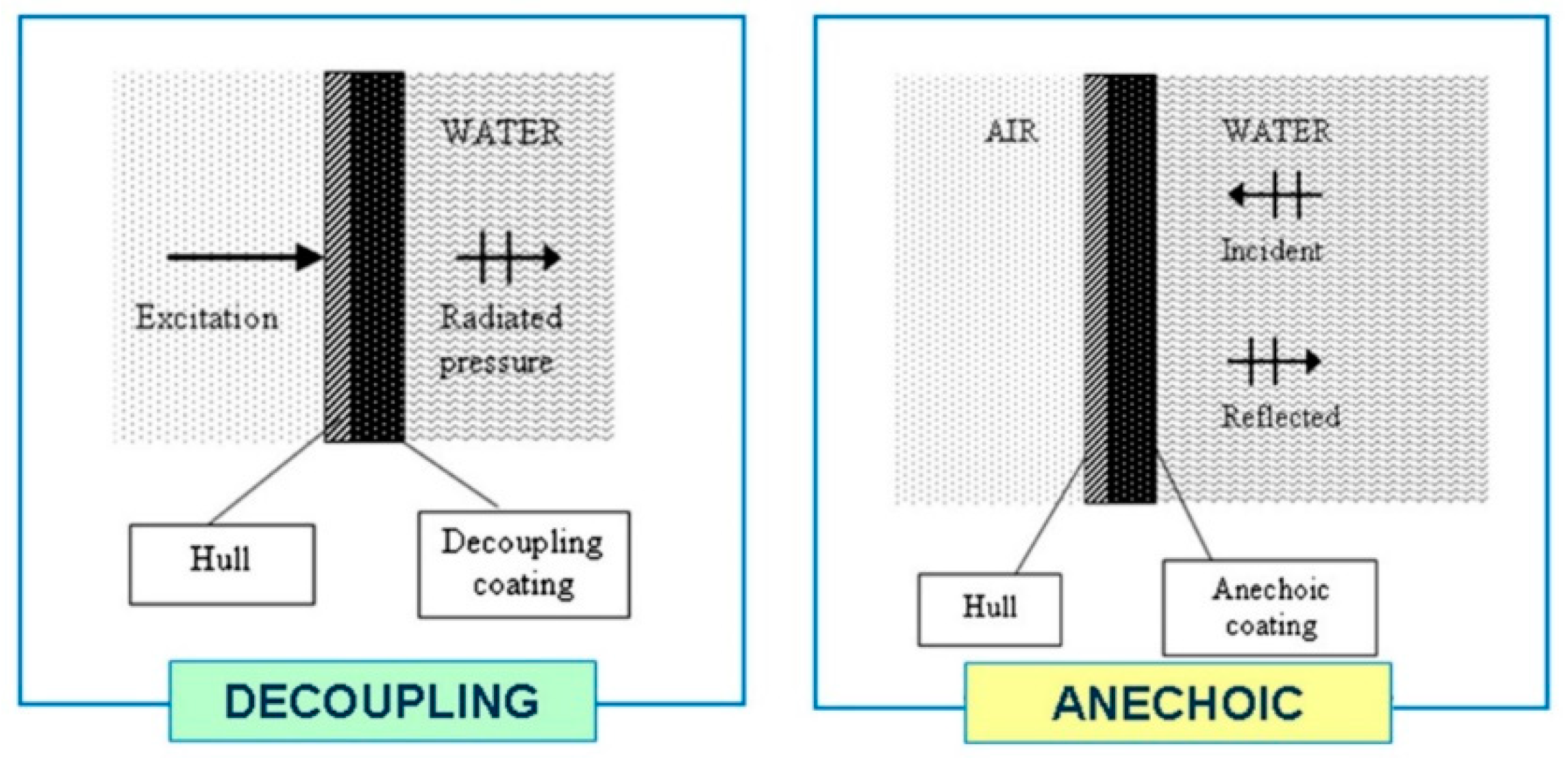
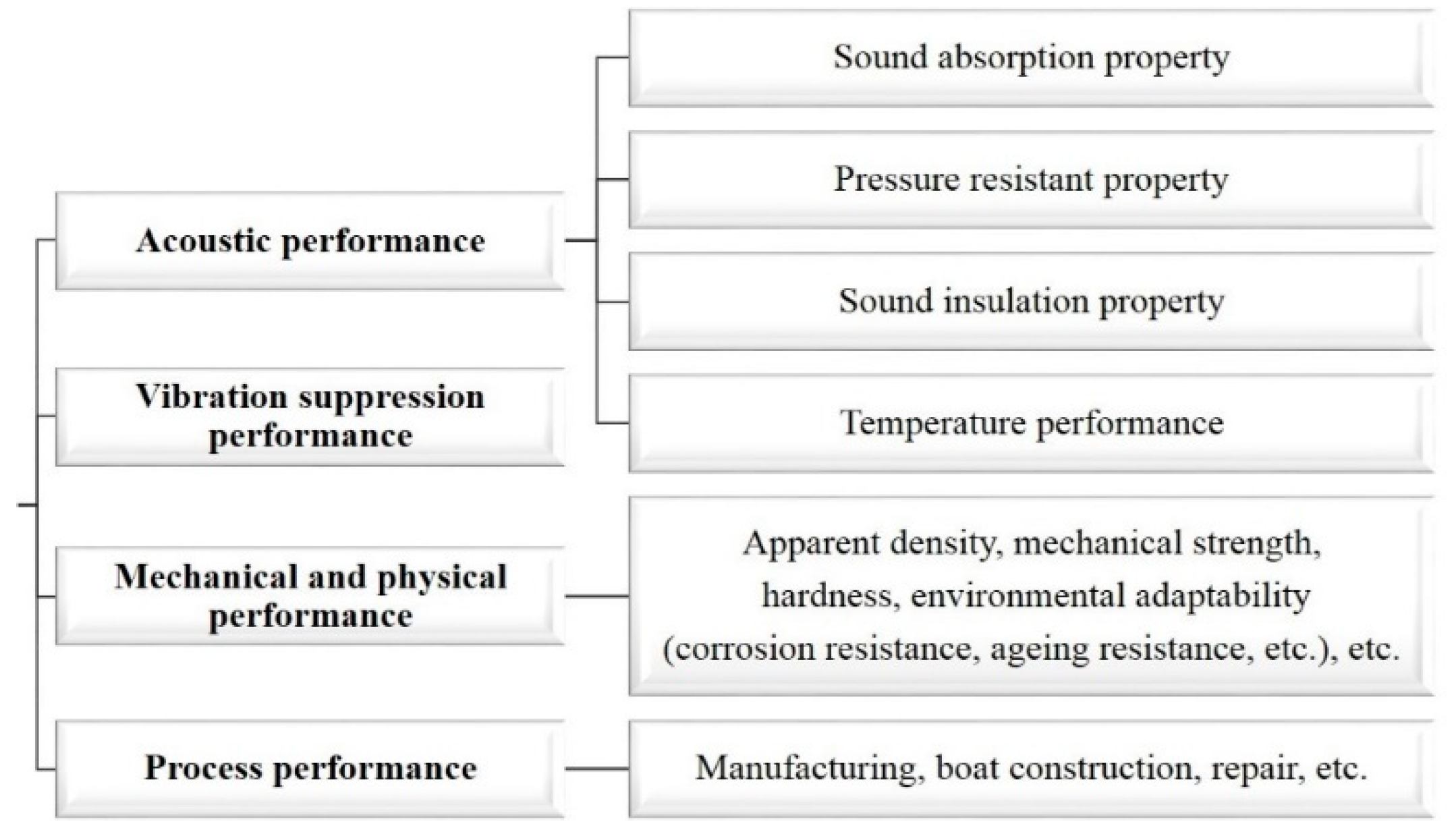

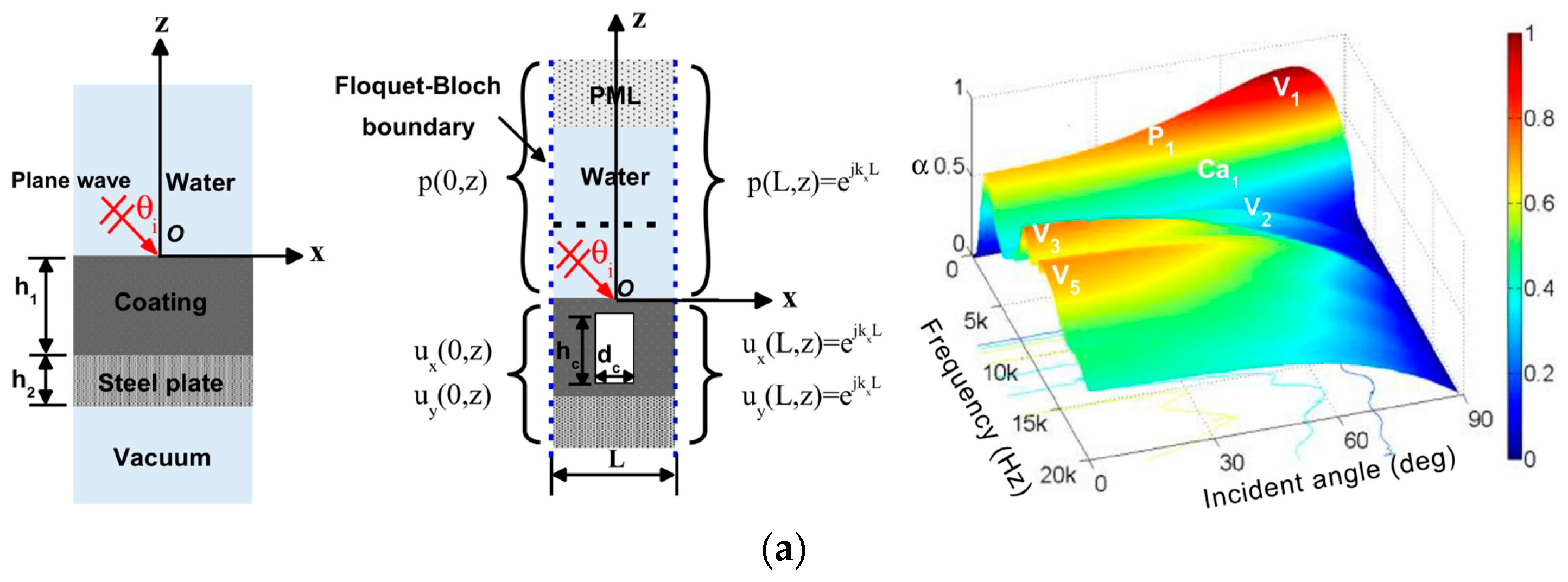
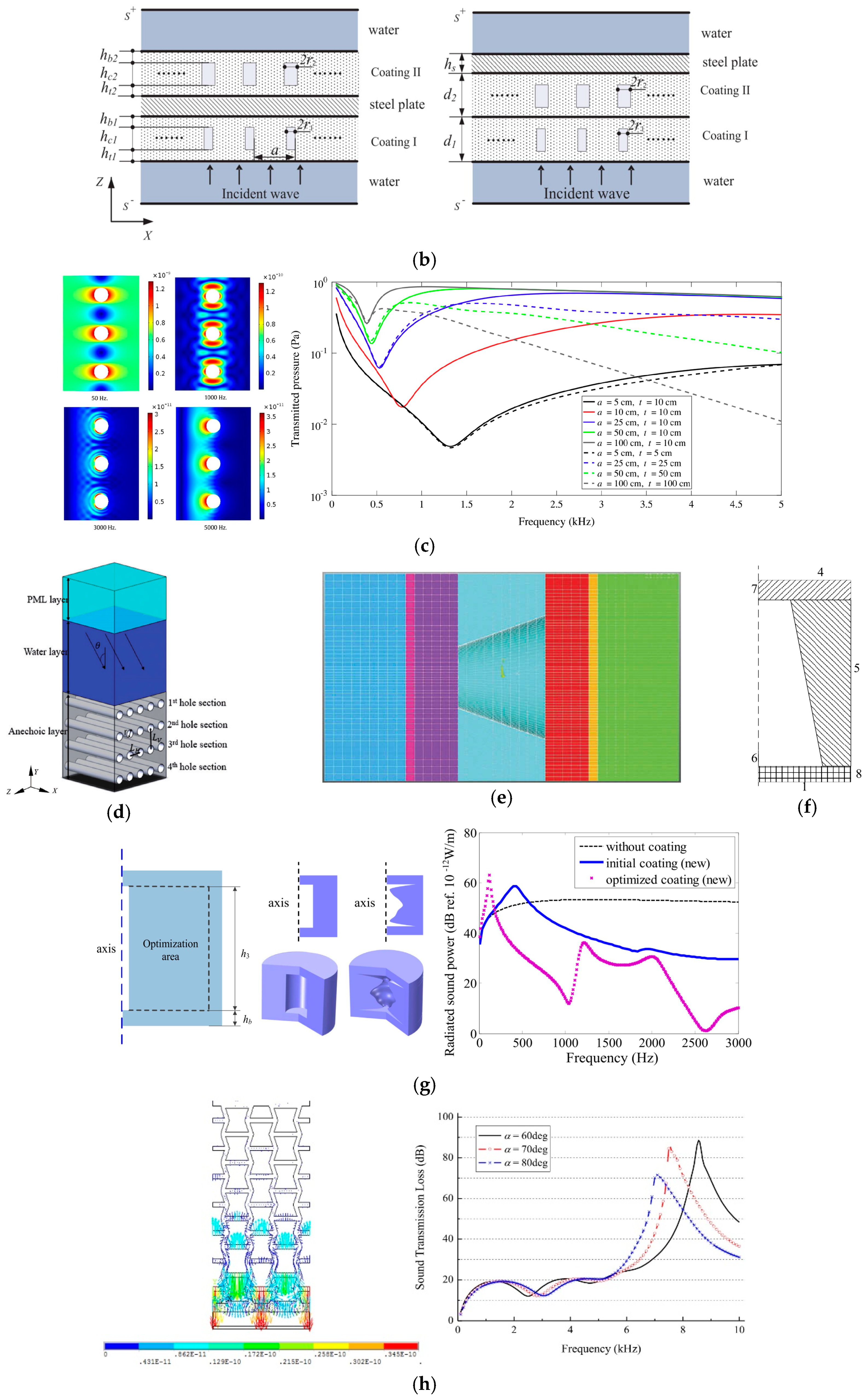


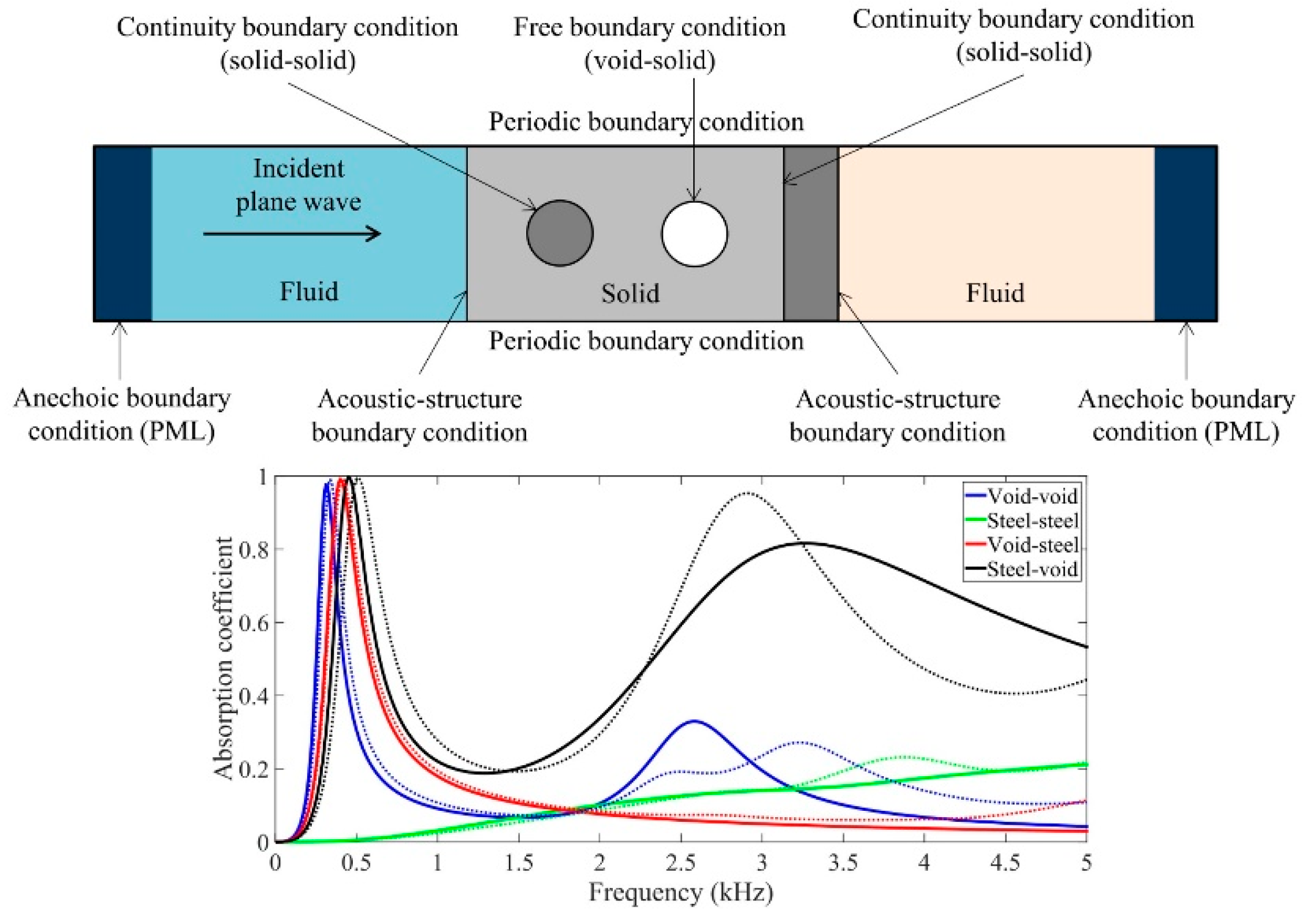


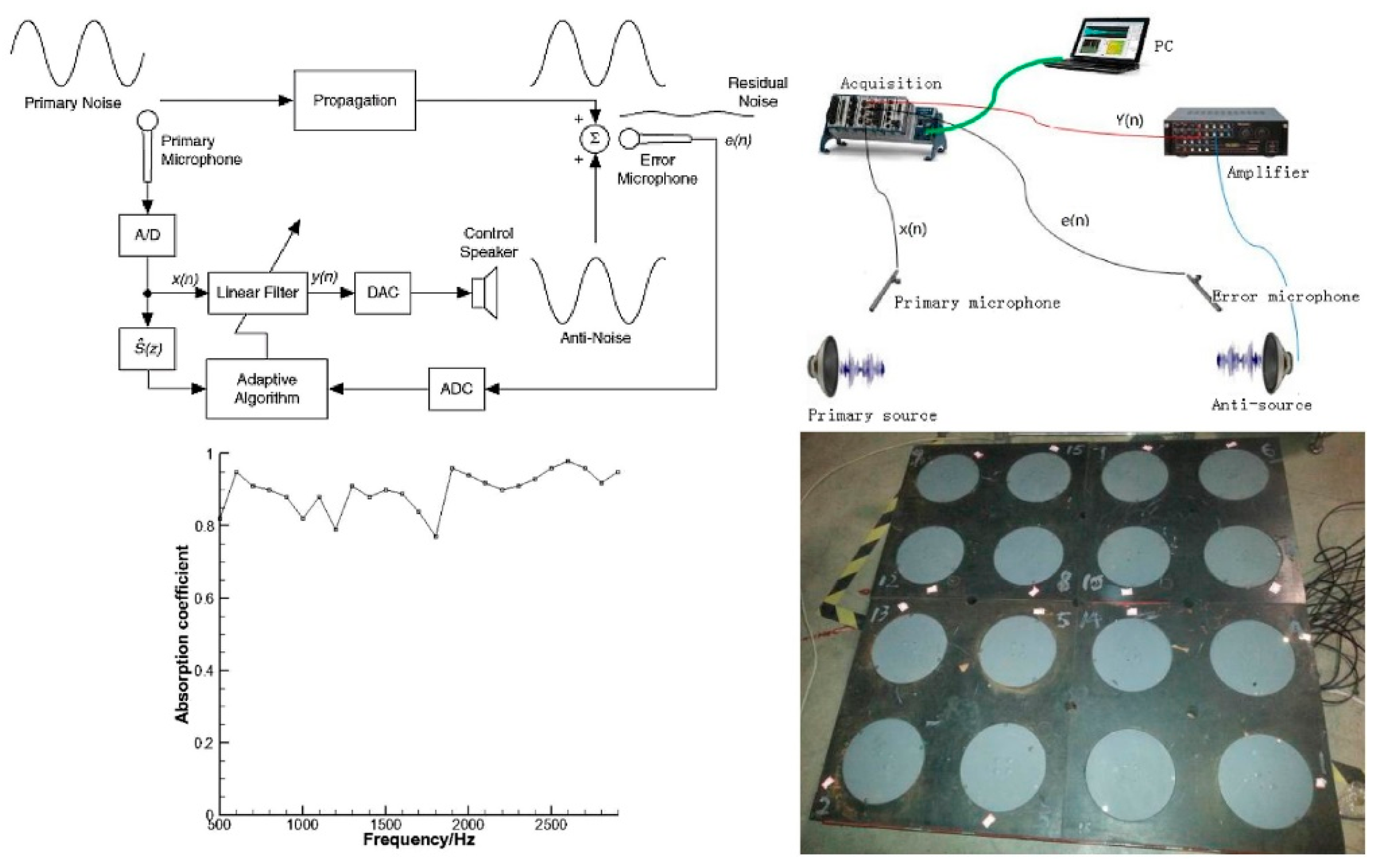


| Country | Acoustic Coating Substrates |
|---|---|
| Germany | Composite rubber |
| United States | Polyurethane, glass fiber, butyl rubber |
| Russia | Styrene-butadiene rubber, polybutadiene rubber, rubber ceramics |
| France | Polyurethane, polysulfide rubber |
| United Kingdom | Polyurethane |
| Japan | Neoprene |
| China | Styrene-butadiene rubber, polyurethane |
| Classification | Main Sound Absorption Mechanism | Advantages and Disadvantages |
|---|---|---|
| pure polymer material | viscous dissipation, heat transfer absorption, molecular relaxation absorption | excellent physical and chemical properties, easy to vulcanization molding, high viscoelasticity and excellent damping properties; large size, generally low strength, not resistant to hydrostatic pressure |
| particle-filled material | acoustic scattering, waveform transformation | improving sound absorption performance, improving the overall strength; large size, random distribution of the particle, its own characteristics are diluted by the matrix material |
| impedance-grading type material | viscoelastic internal friction, elastic relaxation | simple structure, good process molding, good sound absorption effect; large size, energy consumption mechanism is relatively simple |
| porous (foam) material | fluid vibration and friction in the hole | lightweight, high strength, resistant to hydrostatic pressure; bad low-frequency sound absorption performance, not resistant to seawater corrosion |
| cavity resonance type material | cavity resonance, waveform transformation, intrinsic properties of polymer material | better solving the problem of low-frequency sound absorption; low material strength, not resistant to hydrostatic pressure |
| phononic crystal | Bragg scattering, local resonance sound absorption | realizing control of long-wavelength acoustic waves by small-scale materials; regulation band is narrow, polymer matrix will cause bad sound absorption performance with the increase of hydrostatic pressure |
© 2019 by the authors. Licensee MDPI, Basel, Switzerland. This article is an open access article distributed under the terms and conditions of the Creative Commons Attribution (CC BY) license (http://creativecommons.org/licenses/by/4.0/).
Share and Cite
Bai, H.; Zhan, Z.; Liu, J.; Ren, Z. From Local Structure to Overall Performance: An Overview on the Design of an Acoustic Coating. Materials 2019, 12, 2509. https://doi.org/10.3390/ma12162509
Bai H, Zhan Z, Liu J, Ren Z. From Local Structure to Overall Performance: An Overview on the Design of an Acoustic Coating. Materials. 2019; 12(16):2509. https://doi.org/10.3390/ma12162509
Chicago/Turabian StyleBai, Hongbai, Zhiqiang Zhan, Jinchun Liu, and Zhiying Ren. 2019. "From Local Structure to Overall Performance: An Overview on the Design of an Acoustic Coating" Materials 12, no. 16: 2509. https://doi.org/10.3390/ma12162509
APA StyleBai, H., Zhan, Z., Liu, J., & Ren, Z. (2019). From Local Structure to Overall Performance: An Overview on the Design of an Acoustic Coating. Materials, 12(16), 2509. https://doi.org/10.3390/ma12162509




